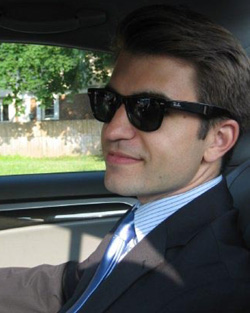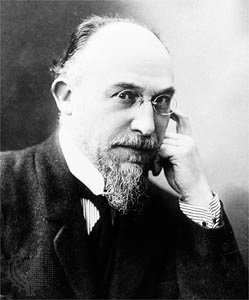|
The Steiny Road Poet asks what is a Markov chain and how does this relate to the new work-in-progress opera How Many Midnights, an opera about the love story of American ex-pat writers Jane and Paul Bowles?
HMM, as composer John Supko refers to this highly experimental work with libretto by poet Karren LaLonde Alenier, is constantly being recreated musically by the use of generative computer processes, including the use of the random statistical process known as Markov chains. Supko selectively creates what he calls an environment—a set of musical parameters such as tempo, rhythm, harmony, melodic details that propagates in such a way that the cumulative effect offers what Dan Ruccia characterizes in Supko's recent premiere for string quartet "Inland Ocean" as "a series of gradually changing textures and interrelated moments—flutters of rhythmic and harmonic activity within a field of stasis."
Lest, Dear Reader, you are now allowing your eyes to glaze with misapprehension, the Steiny Road Poet will provide another Cubist cut on this kind of music created by calculated chance. Try these characteristics: tonal, fluid, optimistic, and squarely positioned in the present moment. Gertrude Stein would be all ears for this music that embodies the philosophic principles of her Harvard teacher William James.
 When the Steiny Road Poet met John Supko along the Seine to share glasses of pastis, the composer was researching Erik Satie for the doctorate he earned the next year at Princeton. What interested Supko about Satie's music was harmonic ambiguity, mosaic construction, and incorporation of both "high" and "low brow" materials. When the Steiny Road Poet met John Supko along the Seine to share glasses of pastis, the composer was researching Erik Satie for the doctorate he earned the next year at Princeton. What interested Supko about Satie's music was harmonic ambiguity, mosaic construction, and incorporation of both "high" and "low brow" materials.
What is harmonic ambiguity? As the Poet understands the term, harmonic ambiguity is created by harmonies that do not seem to have a clear tonal center—they take surprise turns, don't return to "home", etc. This could be the result of the composer choosing not to establish the tonality and deliberately introducing a little harmonic chaos. What's interesting is the part that dissonance can play in the resolution of such chaotic ambiguity. However, that discussion is better left for another more in-depth discussion by someone more knowledgeable than the Poet.
Moving on to mosaic construction, the Poet imagines this to mean an overlay of distinct musical parts that might equate in the visual arts to paintings or other kinds of visible imagery.
Finally the mix of classical techniques or quotations (High Art) and folk or jazz elements (Low Art) completes this inventory (mind you, in a very unsophisticated way) of what John Supko finds appealing in Erik Satie.
 Why the Poet bothers to explore these aspects of Satie's music is that they seem so literary and in tune with the way the Steiny Road Poet thinks and writes. Having come from a family that combined high and low music (a brother and sister with perfect pitch who first learned classical approaches respectively to piano and violin while Dad, unschooled in reading music, played drums in a dance band), the Poet thinks it is normal to combine a fugue with jazz improvisation and perhaps this is a lead into harmonic ambiguity and the layering of imagery. Why the Poet bothers to explore these aspects of Satie's music is that they seem so literary and in tune with the way the Steiny Road Poet thinks and writes. Having come from a family that combined high and low music (a brother and sister with perfect pitch who first learned classical approaches respectively to piano and violin while Dad, unschooled in reading music, played drums in a dance band), the Poet thinks it is normal to combine a fugue with jazz improvisation and perhaps this is a lead into harmonic ambiguity and the layering of imagery.
While the Poet knows John Supko considers Brian Eno and John Cage his musical ancestors, Supko's interest in Erik Satie holds her attention because she has lived loving Satie's music for decades. Satie's Gymnopédies have always seemed mystical to her and now that she knows they were influenced by Medieval music, which she dearly loves, she can sense this kind of connection in the music generated by Markov chains. All of this not so far from Stein's "rose is a rose is a rose."
Stay tuned for more information about How Many Midnights. For now, for those who are interested, some of the poems that became part of the libretto for this opera can be seen in The Innisfree Poetry Journal. In the fall of 2011, Kattywompus Press will publish a chapbook containing all the poems that form How Many Midnights.
|


